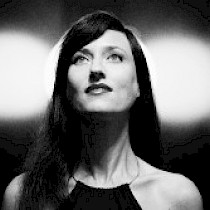Prof. Vesna Petresin

Vesna Petresin (geboren in Ljubljana, arbeitet und lebt in Berlin und London) ist eine transdisziplinäre Künstlerin und Denkerin. Als “Time-Architect“ beschäftigt sie sich mit Kompositionen und Darbietungen aus Sound, Licht, Rhythmus, Raum, Bewegung, Text und Code.
Aktuell ist sie als Visiting Fellow am Goldsmiths College der Universität von London sowie als Artist-in-Residence des ZKM | Zentrum für Kunst und Medien Karlsruhe tätig und promovierte im Bereich „Temporal Composition in Architecture, Art and Music“. Sie gilt als Mitbegründerin des seit 2004 existierenden Kunstkollektivs und Think Tanks „Rubedo“ in London, welches Themen und Techniken rund um Ästhetik, komplexe Geometrie, Optik sowie Akustik anhand von Darbietungen, Installationen und Artefakten erforscht.
In der Praxis untersucht Vesna neben Grenzen zwischen Intimität und Öffentlichkeit, die Verkörperung, Transformation und Manipulation von Zeit und Bewegung sowie die Synästhesie synkretistischer Kunst.
Sie strebt danach, Kunst aus dem ‚White Cube‘ zu holen und sie zu einem immersiven Erlebnis werden zu lassen sowie Sound in Relation zu Raum, Zeit und Benutzerinteraktion zu erforschen. Mithilfe ihrer Stimm- und Bewegungs-Mediation konstruiert sie eine Trichotomie von Strukturen - Sound, Bild und Licht - und erforscht das Konzept von Zeit in Relation zu Körper, Bewegung, Raum und Emotionen.
Sie hat bereits zahlreiche Performances, immersive Erlebnisse, Multimedia-Installationen und Artefakte auf internationalen Festivals und Orten, wie dem Tate Modern, der ArtBasel Miami, der Royal Festival Hall, der Royal Academy of Arts, der Venice Biennale, dem Cannes International Film Festival, dem Institute of Contemporary Arts London, CERN, dem Sydney Opera House, Vienna Secession, dem World Architecture Festival und der Beijing Architecture Biennale ausgestellt und dargeboten.
Zudem war Vesna als „Industry Advisor“ am Goldsmiths College und der Bath University tätig und erhielt Industrie- und Kunstzuschüsse (British Council, UK Govt. Department of Innovation, Business and Skills, Arts Council, Crafts Council) sowie Patente für das Ingenieurwesen. Des Weiteren arbeitete sie als Lehrbeauftragte und als öffentliche Sprecherin (UCL, Goldsmiths, Central Saint Martins, Architectural Association, ZKM), veröffentlichte weltweit ihre Werke (Thames & Hudson, Springer, John Wiley & Academy) und ist Mitglied der Royal Society of Arts.
Synopsis
Present continuous
Matter is information.
As the world of technology focuses on the the process from bits to particles and from particles back to bits, the impact of social change through technology gives rise to a digital world order. Here, our value is defined by what we contribute to data processing.
The culture of flow, Interaction, sharing, tracking, prosuming, redefines ways in which we learn, work, trade, communicate and relax.
In the world when the ancient myths are fused with emergent godlike technologies such as artificial intelligence and genetic engineering, how will we define what it means to be human?
Instant manifestation is the new holy grail, as desire rapidly becomes experience.
To escape the threat of the Real, we created a virtual utopia - a traumatic scene that never really took place. It is a false liberation from the constraints of the social space in which our existence is caught.
In this avalanche of growth and abundance, the gap with the world of poverty and abuse of human rights is increasing. It may be timely to pause and question, to reconsider the art of consciousness, to reflect and act in the present to shape a future through values of humanism, including personal freedom of expression, sexual emancipation, and environmental responsibility.
People are driven by stories as much as by physical existence. Thinking through making art may show alternative to creating narratives, creating desirable improbabilities for our future, and bringing nature and technology together in exciting and meaningful new ways.
Alle Sprecher
- Yasser Almaamoun
- Thorsten Bauer
- Sergey Biniaminov
- Christopher Coenen
- Prof. Ina Conradi
- Prof. Dr.-Ing. Barbara Deml
- Hon. Prof. Joséphine Derobe
- Florian Dohmann
- Felix Gaedtke
- Diego González-Zúñiga
- Prof. Lisa Gotto
- Dr. Lily Hibberd
- Prof. Johan Frederik Hartle
- Dr. Rocio von Jungenfeld
- Sönke Kirchhof
- Mario Klingemann
- Dr. Elias Knubben
- Dr. Sebastian Knorr
- Prof. Verena Kraemer
- Prof. Susanne Kriemann
- Dr. Barbara Kuon
- Prof. Frederic Fol Leymarie
- Roman Lipski
- Anja-Maria Meister
- Prof. Galina Mihaleva
- Prof. Dr. Eduardo R. Miranda
- Lauren Moffatt
- Prof. Julian Oliver
- Prof. Dr. Dr.-Ing. Jivka Ovtcharova
- Gülsel Özkan
- Prof. Matteo Pasquinelli
- Prof. Vesna Petresin
- Prof. Dr. Mark Post
- Oliver Rack
- Prof. Elke Reinhuber
- Prof. Christiane Riedel
- Dr. Ralf Schäfer
- Prof. Benjamin Seide
- Dr. Markus Schmidt
- Kathleen Schröter
- Prof. Aljoscha Smolic
- Prof. Vibeke Sorensen
- Prof. João Tabarra
- Cyril Tuschi
- Holger Volland
- Dr. Lioudmila Voropai
- Yulu Wang
Kontakt
Interesse? Fragen?
Rufen Sie uns an:
+49 (0)721 / 8100 6001
oder schreiben Sie uns:
info@beyondfestival.com




